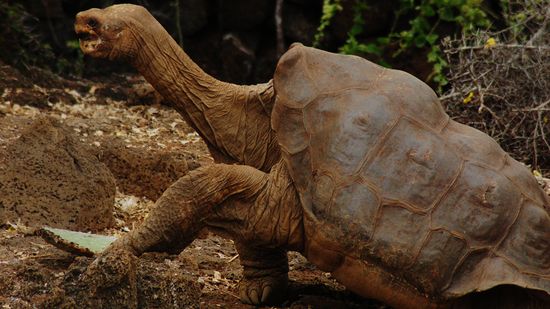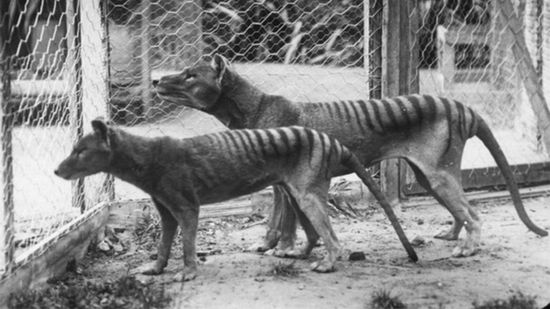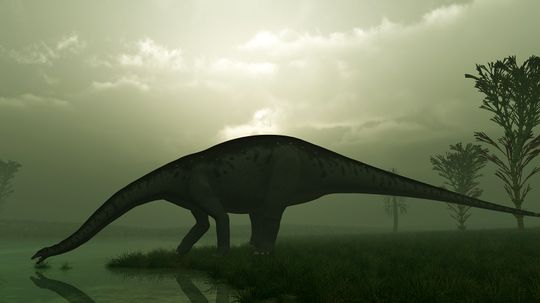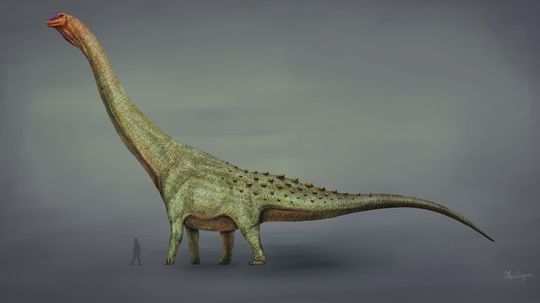Extinct Animals
Extinct animals are those species which are no longer living. This group includes prehistoric animals like dinosaurs and ice-age mammals, as well as moden species like the Dodo.

12 Scariest Dinosaurs You'd Want to Avoid While Time Traveling

The Smartest Dinosaur (and 9 More Clever Prehistoric Reptiles)

Pteranodon vs. Pterodactyl: Comparing Non-dinosaur Species

Are Snakes With Legs a Real Thing?

There Were No Flying Dinosaurs, Only Flying Reptiles

All About the Megalodon, Shark Giant of Prehistoric Times

The Most Recent Extinct Animal Was Last Seen in 1995

Real Life 'Jurassic Park'? Scientists Work to Bring Back Extinct Thylacine

Once Thought Extinct, the Tasmanian Tiger May Still Be Prowling the Planet
Learn More
Some of the scariest dinosaurs ever to walk the Earth were terrifying for reasons beyond their size. They were dangerous animals with tools perfectly evolved for hunting, ambushing, or defending against other dinosaurs.
By Nico Avelle
Which were the smartest dinosaurs? While we can't sit a Velociraptor down for an IQ test, scientists use fossil evidence like brain cavity size and body ratios to make educated guesses.
By Nico Avelle
If you've ever watched a dinosaur documentary or strolled through a natural history museum, you've probably heard a narrator make a big difference about pteranodon vs. pterodactyl species.
By Nico Avelle
Advertisement
Dinosaurs ruled the Earth for over 160 million years, and two of the most talked-about giants are facing off in a battle of legends: Giganotosaurus vs. T rex.
By Nico Avelle
Brontosaurus vs. Brachiosaurus species are easy to confuse. They're two dinosaurs, both giants, both sauropods, but vastly different in some key ways.
By Zach Taras
Today, we're delving into a sobering topic: recently extinct animals. Species extinction is accelerating, with many species disappearing due to habitat destruction, invasive species and climate change.
By Yara Simón
Today, we're diving deep into the world of Carcharodontosaurus, one of the most fearsome meat-eating dinosaurs to ever roam the Earth.
By Zach Taras
Advertisement
Travel back about 95 million years ago to the Late Cretaceous period, and you might just find a "boar crocodile" called the kaprosuchus.
By Ada Tseng
Quetzalcoatlus northropi wasn't just big; it was ginormous! As the largest flying animal yet discovered, Quetzalcoatlus continues to fascinate paleontologists and average people alike.
By Zach Taras
Troodon, a theropod dinosaur, has captured the curiosity of paleontologists for decades. Known for its sharp wits and fascinating features, Troodon possesses some of the most intriguing traits of the dinosaur world.
By Mack Hayden
Hey there, dinosaur fans! Let’s talk about one of the most fascinating extinct animals of all time: Iguanodon! Discovered in the early 19th century, Iguanodon was one of the very first dinosaurs ever named, and it played a huge role in kicking off the field of paleontology. With its iguana tooth-like structures and unique anatomy, this medium-sized herbivorous dinosaur became an instant sensation for scientists and dinosaur lovers alike.
By Mack Hayden
Advertisement
Hey there, dinosaur enthusiasts! Let’s dive into the world of Ceratosaurus, a predator of the Jurassic period.
By Talon Homer
That's the titanosaur, one of the largest land animals to ever exist, dwarfing nearly everything around it. Roaming the planet during the Late Cretaceous period — approximately 100 million years ago — titanosaurs are part of a family of sauropod dinosaurs known for their massive size, long necks and incredible diversity.
By Talon Homer
Argentinosaurus is one of the largest known dinosaurs to have ever walked the Earth, and its sheer size captures the imagination of scientists and enthusiasts alike.
By Talon Homer
They lived about 30 million years apart and never set foot on the same continent. Yet Giganotosaurus carolinii is always getting compared to the world's most popular dinosaur, the beloved and well-known Tyrannosaurus rex, both vying for the position of the largest carnivorous dinosaur in history.
By Mark Mancini & Talon Homer
Advertisement
The next time a 4-year-old asks what the biggest dinosaur ever was, you can respond confidently: It was the titanosaur Patagotitan mayorum (simply "Patagotitan" for short), a colossal creature that lived more than 100 million years ago during the Late Cretaceous period.
By Ada Tseng
Dinosaurs ruled the Earth millions of years ago, and while many were peaceful herbivores, others were some of the most dangerous animals to ever walk the planet.
By Mack Hayden
Have you ever wondered if snakes used to have legs? Believe it or not, snakes didn’t always slither on the ground like they do today. In fact, once upon a time, snakes with legs really did roam Earth, and scientists have found some pretty incredible clues to prove it.
By Zach Taras
It can be fun to imagine what it was like when dinosaurs were alive on Earth, lurking under the water, defending their territories on land and soaring through the sky. But wait, that imaginary scenario is technically inaccurate. As it turns out, there were no flying dinosaurs, only flying reptiles.
By Marie Look
Advertisement
The megalodon shark has intrigued scientists and the public alike with its nearly unfathomable size and power. Once ruling the ancient oceans, this prehistoric predator is often cited as the largest shark to have ever lived and even inspired a Jason Statham movie franchise.
Determining the biggest dinosaur is a tricky process. Dinosaurs are extinct, so scientists can't simply go out and measure the world's biggest dinosaurs.
By Sascha Bos
If you like swimming in the ocean, you'll probably be glad to hear that Palaeophis colossaeus, a 40-foot sea snake, has been extinct for millions of years.
Before the 2003 discovery of Titanoboa cerrejonensis, Gigantophis garstini was known as the largest snake to ever roam the Earth.
Advertisement
Bringing a species back from extinction might not be the stuff of sci-fi any longer.
Utahraptors lived around 135 million years ago in the late Cretaceous Period. So what does salt have to do with these massive dinosaurs whose fossils were first discovered in 1975?
By Mark Mancini
























